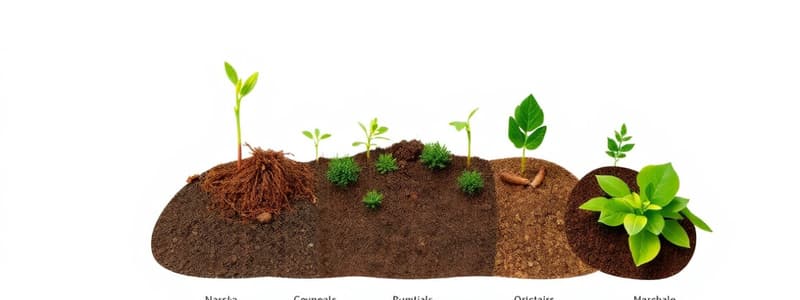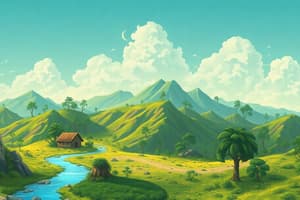Podcast
Questions and Answers
কোন উৎসের ভিত্তিতে চারটি বিভাগের শ্রেণীবিভাগ করা হয়?
কোন উৎসের ভিত্তিতে চারটি বিভাগের শ্রেণীবিভাগ করা হয়?
- দেশীয়, আন্তর্জাতিক, সামাজিক, আর্থিক
- শ্রমিক, প্রযুক্তিগত, আর্থিক, সামাজিক
- নতুন, পুরানো, অত্যাধुनिक, প্রাকৃতিক
- মৌলিক, অমৌলিক, পুনর্নবীকরণযোগ্য, অ-পুনর্নবীকরণযোগ্য (correct)
উৎসের ভিত্তিতে কোনটি 'পুনর্নবীকরণযোগ্য' উৎস হিসেবে বিবেচিত হয়?
উৎসের ভিত্তিতে কোনটি 'পুনর্নবীকরণযোগ্য' উৎস হিসেবে বিবেচিত হয়?
- কোল
- কেন
- জল (correct)
- প্রাকৃতিক গ্যাস
কারণ অনুসারে, অনিয়মিত সম্পদের ব্যবহারের ফলে কোন সমস্যাগুলি সৃষ্টি হতে পারে?
কারণ অনুসারে, অনিয়মিত সম্পদের ব্যবহারের ফলে কোন সমস্যাগুলি সৃষ্টি হতে পারে?
- ধনীদের সংখ্যা বৃদ্ধি, শ্রমজীবী দীক্ষা
- নতুন প্রযুক্তির উদ্ভাবন, জনসংখ্যা বৃদ্ধি
- পরিবেশগত ক্ষতি, দারিদ্র্য বৃদ্ধি (correct)
- স্থানীয় উষ্ণায়ন, বৈশ্বিক প্রভাব
এজেন্ডা 21 এর মূল লক্ষ্য কী?
এজেন্ডা 21 এর মূল লক্ষ্য কী?
কোনটি সম্পদের পরিকল্পনার প্রয়োজনীয়তার একটি কারণ?
কোনটি সম্পদের পরিকল্পনার প্রয়োজনীয়তার একটি কারণ?
মাটি ক্ষয়ের কারণের মধ্যে কোনটি অন্তর্ভুক্ত নয়?
মাটি ক্ষয়ের কারণের মধ্যে কোনটি অন্তর্ভুক্ত নয়?
কোনটি গলির সঠিক সংজ্ঞা?
কোনটি গলির সঠিক সংজ্ঞা?
কোনটি মাটি সংরক্ষণের একটি পদ্ধতি নয়?
কোনটি মাটি সংরক্ষণের একটি পদ্ধতি নয়?
বন মাটির গঠন কিভাবে ঘটে?
বন মাটির গঠন কিভাবে ঘটে?
শীট ক্ষয় কিসের মাধ্যমে ঘটে?
শীট ক্ষয় কিসের মাধ্যমে ঘটে?
ভারতের ভূমির ব্যবহার প্যাটার্নের মধ্যে, 2008 সালে বর্তমান পতিত জমির শতাংশ কত ছিল?
ভারতের ভূমির ব্যবহার প্যাটার্নের মধ্যে, 2008 সালে বর্তমান পতিত জমির শতাংশ কত ছিল?
কোন কারণে ভূমির অধঃপতন ঘটে?
কোন কারণে ভূমির অধঃপতন ঘটে?
কোন মাটি খরা আবহাওয়া এলাকার জন্য উপযুক্ত?
কোন মাটি খরা আবহাওয়া এলাকার জন্য উপযুক্ত?
কিভাবে পদার্থ বিরোধী ভূমির সৃষ্টি হয়?
কিভাবে পদার্থ বিরোধী ভূমির সৃষ্টি হয়?
কোন জাতের মাটি ধূসর এবং হলুদ রঙের?
কোন জাতের মাটি ধূসর এবং হলুদ রঙের?
সর্বাধিক জল ধরে রাখতে সক্ষম কোন মাটির জাত?
সর্বাধিক জল ধরে রাখতে সক্ষম কোন মাটির জাত?
ভারতে ভারতীয় ভূমিরসদের কোন মৌলিক ব্যবহার নেই?
ভারতে ভারতীয় ভূমিরসদের কোন মৌলিক ব্যবহার নেই?
ভারতের ভূগোল অনুযায়ী, ১৯৬০-61 সালের সময়ে দেশের মোট কৃষিকাজের জমির শতাংশ কত ছিল?
ভারতের ভূগোল অনুযায়ী, ১৯৬০-61 সালের সময়ে দেশের মোট কৃষিকাজের জমির শতাংশ কত ছিল?
कौन सी माटी हुमस की कमी से ग्रस्त होती है?
कौन सी माटी हुमस की कमी से ग्रस्त होती है?
Flashcards
জৈব সম্পদ
জৈব সম্পদ
জীবন্ত জিনিস থেকে উৎপন্ন সম্পদ, যেমন উদ্ভিদ এবং প্রাণী।
অজৈব সম্পদ
অজৈব সম্পদ
অজৈব উৎস থেকে প্রাপ্ত সম্পদ, যেমন বাতাস এবং জল।
পুনর্নবীকরণযোগ্য সম্পদ
পুনর্নবীকরণযোগ্য সম্পদ
পুনর্নবীকরণযোগ্য সম্পদ, যেমন জল, যা প্রাকৃতিকভাবে পুনর্নবীকরণ হয়।
অপুনর্নবীকরণযোগ্য সম্পদ
অপুনর্নবীকরণযোগ্য সম্পদ
Signup and view all the flashcards
সম্পদের পরিকল্পনা
সম্পদের পরিকল্পনা
Signup and view all the flashcards
মাটি ক্ষয় কী?
মাটি ক্ষয় কী?
Signup and view all the flashcards
মাটি ক্ষয়ের কারণগুলি কী কী?
মাটি ক্ষয়ের কারণগুলি কী কী?
Signup and view all the flashcards
পাহাড়ি মাটি
পাহাড়ি মাটি
Signup and view all the flashcards
পাতলা ক্ষয়
পাতলা ক্ষয়
Signup and view all the flashcards
মাটি ক্ষয় রোধের পদ্ধতি
মাটি ক্ষয় রোধের পদ্ধতি
Signup and view all the flashcards
সংস্থান বিতরণের অসমতা
সংস্থান বিতরণের অসমতা
Signup and view all the flashcards
সংস্থান পরিকল্পনা
সংস্থান পরিকল্পনা
Signup and view all the flashcards
সংস্থান সংরক্ষণ
সংস্থান সংরক্ষণ
Signup and view all the flashcards
ভারতের ভূমি প্রকার: ভূমি
ভারতের ভূমি প্রকার: ভূমি
Signup and view all the flashcards
ভারতের ভূমি প্রকার: পর্বত
ভারতের ভূমি প্রকার: পর্বত
Signup and view all the flashcards
ভারতের ভূমি প্রকার: উচ্চভূমি
ভারতের ভূমি প্রকার: উচ্চভূমি
Signup and view all the flashcards
ভূমি ব্যবহার চার্ট
ভূমি ব্যবহার চার্ট
Signup and view all the flashcards
মাটির স্তর: উপরের মাটি
মাটির স্তর: উপরের মাটি
Signup and view all the flashcards
মাটির স্তর: উপস্তর
মাটির স্তর: উপস্তর
Signup and view all the flashcards
মাটির স্তর: মূল শিলা স্তর
মাটির স্তর: মূল শিলা স্তর
Signup and view all the flashcards
Study Notes
Resource and Development
- Resources are categorized by origin (biotic/abiotic), ownership (individual, community, national, international), renewability (renewable/non-renewable), and development status (potential/developed).
- Availability of technology and willingness to use a resource are crucial for development.
- Indiscriminate resource use leads to depletion of resources and global ecological crises.
- Sustainable development is crucial, guided by the Rio Earth Summit (1992) and Agenda 21, emphasizing local government action.
Classification of Resources
- Resources can be categorized based on origin: biotic (plants, animals) and abiotic (air, water).
- They can also be categorized by ownership: individual, community, national, international.
- Renewability is another important factor: some resources are renewable (water), while others are non-renewable (coal).
Land Resources
- Land resources include plains (43%), mountains (30%), and plateaus (27%) in India.
- Land utilization includes forests, agricultural land, wastelands, pastures, and land put to other (non-agricultural) uses.
- Fallow land is categorized by duration (current, other).
Land Use Pattern in India (2008)
- Net sown area occupies 46.24%.
- Forests cover 22.78%.
- Barren and wastelands constitute 8.68%.
- Pastures and grazing lands make up 4.72%.
- Non-agricultural areas account for a significant portion.
Land Degradation and Conservation
- Land degradation is caused by deforestation, overgrazing, mining, over-irrigation, and mineral processing industries.
- Measures to conserve land include: afforestation, management of grazing land, regulating mining activities, employing drip irrigation, planting shelter belts, and using thorny bushes.
Soil as a Resource
- Soil is a renewable natural resource supporting plant growth and life in different areas.
- Soil's layers include top soil, subsoil, substratum, parent rock material, and bedrock.
Classification of Soils
- Alluvial soil is formed by river deltas (Himalayan rivers) and predominant in northern plains, coastal areas, Duars, Chos, and Terai.
- Black soil is prevalent on the Deccan Plateau (Maharashtra, Saurashtra, Malwa, Madhya Pradesh, and Chhattisgarh). It's clayey, holds water well, and is suitable for cotton and sugarcane cultivation.
- Red and yellow soil is found in south-eastern and eastern parts of India, formed from crystalline igneous rocks. It's suitable for tea, coffee, and rubber cultivation.
- Laterite soil is present in the Western Ghats and north eastern parts of India, with high temperature and heavy rainfall. This soil lacks humus and has specific crops like plantation crops.
- Arid soil is in the north-western part of India, with high temperatures and low rainfall. It has a sandy texture and is often saline.
Soil Erosion and Soil Conservation
- Soil erosion involves the removal of topsoil due to various factors (overgrazing, construction, mining, faulty farming techniques, wind, glaciers, and water).
- Soil conservation methods include contour ploughing, terrace farming, strip farming, and planting shelter belts.
Questions and Answer Writing Discussion
- Various questions about resources, types of resources, problems of indiscriminate resource use, sustainable development, Agenda 21, steps in resource planning, Gandhi's statements, land utilization, causes of land degradation, conservation methods, soils (alluvial, khadar and bangar), and development status definitions are included.
Studying That Suits You
Use AI to generate personalized quizzes and flashcards to suit your learning preferences.




